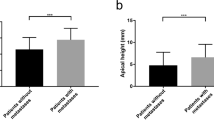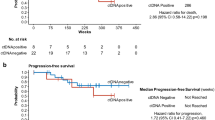Abstract
Background
About 50% of patients with uveal melanoma (UM) develop metastases during the course of their disease. We analyzed serum levels of Growth Differentiation Factor-15 (GDF-15), with the aim of identifying patients with early metastases.
Methods
GDF-15 concentration was measured using an enzyme-linked immunosorbent assay (ELISA) in serum samples from 188 UM patients (170 patients without metastases; 18 patients with clinically detectable metastases) and 18 healthy control individuals. Data were analyzed with respect to differences between patients with and without clinically detectable UM metastases. GDF-15 serum levels were further analyzed with regard to significant patient and tumor characteristics as revealed by histology and multiplex ligation-dependent probe amplification (MLPA) to determine chromosome 3 copy number. GDF-15 expression in UM was investigated by immunohistochemistry.
Results
Patients with clinically detectable metastases had significantly higher GDF-15 serum levels compared to those without clinically detectable metastases as well as to healthy individuals (ANOVA; p < 0.001). GDF-15 concentrations in UM patients with overt clinically detectable metastases were significantly higher than those in UM patients with a second malignancy in remission but without clinically detected UM metastases (ANOVA; p < 0.001). No association between serum concentration of GDF-15 and clinical, pathological, and genetic features was observed. GDF-15 protein was only expressed in a minority of UM cells in most tumors.
Conclusions
Our data suggest that GDF-15 can be used as a serum marker for the diagnosis of metastases in UM patients. Further data collection and analysis are necessary to evaluate a possible prognostic role of GDF-15 in predicting early metastases.






Similar content being viewed by others
References
Singh AD, Topham A (2003) Incidence of uveal melanoma in the United States: 1973–1997. Ophthalmology 110:956–961
Shields CL, Shields JA, Cater J, Lois N, Edelstein C, Gündüz K, Mercado G (1998) Transpupillary thermotherapy for choroidal melanoma. Tumor control and visual results in 100 consecutive cases. Ophthalmology 105:581–590
Gragoudas E, Li W, Goitein M, Lane AM, Munzenrider JE, Egan KM (2002) Evidence-based estimates of outcome in patients irradiated for intraocular melanoma. Arch Ophthalmol 120:1665–1671
Damato B, Groenewald C, McGalliard J, Wong D (1998) Endoresection of choroidal melanoma. Br J Ophthalmol 82:213–218
Verschueren KM, Creutzberg CL, Schalij-Delfos NE, Ketelaars M, Klijsen FL, Haeseker BI, Ligtenberg SM, Keunen JE, Marijnen CA (2010) Long-term outcomes of eye-conserving treatment with Ruthenium(106) brachytherapy for choroidal melanoma. Radiother Oncol 95:332–338
COMS report no. 15 (2001) Assessment of metastatic disease status at death in 435 patients with large choroidal melanoma in the Collaborative Ocular Melanoma Study (COMS). Arch Ophthalmol 119:670–676
Seddon JM, Albert DM, Lavin PT, Robinson N (1983) A prognostic factor study of disease-free interval and survival following enucleation for uveal melanoma. Arch Ophthalmol 101:1894–1899
Mooy CM, De Jong PT (1996) Prognostic parameters in uveal melanoma: a review. Surv Ophthalmol 41:215–228
Folberg R, Rummelt V, Parys-Van Ginderdeuren R, Hwang T, Woolson RF, Peér J, Gruman LM (1993) The prognostic value of tumor blood vessel morphology in primary uveal melanoma. Ophthalmology 100:1389–1398
Prescher G, Bornfeld N, Hirche H, Horsthemke B, Jockel KH, Becher R (1996) Prognostic implications of monosomy 3 in uveal melanoma. Lancet 347:1222–1225
Onken MD, Worley LA, Ehlers JP, Harbour JW (2004) Gene expression profiling in uveal melanoma reveals two molecular classes and predicts metastatic death. Cancer Res 64:7205–7209
Damato B, Duke C, Coupland SE, Hiscott P, Smith PA, Campbell I, Douglas A, Howard P (2007) Cytogenetics of uveal melanoma: a 7-year clinical experience. Ophthalmology 114:1925–1931
Triozzi PL, Eng C, Singh AD (2008) Targeted therapy for uveal melanoma. Cancer Treat Rev 34:247–258
Eskelin S, Pyrhonen S, Summanen P, Prause JU, Kivela T (1999) Screening for metastatic malignant melanoma of the uvea revisited. Cancer 85:1151–1159
Hicks C, Foss AJE, Hungerford JL (1998) Predictive power of screening tests for metastasis in uveal melanoma. Eye 12:945–948
Bootcov M, Bauskin AR, Valenzuela SM, Moore AG, Bansal M, He XY, Zhang HP, Donnellan M, Mahler S, Pryor K, Walsh BJ, Nicholson RC, Fairlie WD, Por SB, Robbins JM, Breit SN (1997) MIC-1, a novel macrophage inhibitory cytokine, is a divergent member of the TGF-β superfamily. PNAS 94:11514–11519
Bauskin AR, Brown DA, Kuffner T, Johnen H, Luo XW, Hunter M, Breit SN (2006) Role of macrophage inhibitory cytokine-1 in tumorigenesis and diagnosis of cancer. Cancer Res 66:4983–4986
Welsh JB, Sapinoso LM, Kern SG, Brown DA, Liu T, Bauskin AR, Ward RL, Hawkins NJ, Quinn DI, Russell PJ, Sutherland RL, Breit SN, Moskaluk CA, Frierson HF Jr, Hampton GM (2003) Large-scale delineation of secreted protein biomarkers overexpressed in cancer tissue and serum. PNAS 100:3410–3415
Boyle GM, Pedley J, Martyn AC, Banducci KJ, Strutton GM, Brown DA, Breit SN, Parsons PG (2009) Macrophage inhibitory cytokine-1 is overexpressed in malignant melanoma and is associated with tumorigenicity. J Invest Dermatol 129:383–391
Damato B, Dopierala J, Klaasen A, van Dijk M, Sibbring J, Coupland SE (2009) Multiplex ligation-dependent probe amplification of uveal melanoma: correlation with metastatic death. Invest Ophthalmol Vis Sci 50:3048–3055
Malignant melanoma of the uvea, Edge SB, Byrd DR, Compton CC, Fritz AG, Green FL, Trotti A (eds) (2010) AJCC Cancer Staging Manual, 7th edn. Springer, New York, Dordrecht, Heidelberg, London, pp 547–560
Schaller UC, Bosserhoff A-K, Neubauer AS, Buettner R, Kampik A, Mueller AJ (2002) Melanoma inhibitory activity: a novel serum marker for uveal melanoma. Melanoma Res 12:593–599
Reiniger IW, Schaller UC, Haritoglou C, Hein R, Bosserhoff AK, Kampik A, Mueller AJ (2005) "Melanoma inhibitory activity" (MIA): a promising serological tumour marker in metastatic uveal melanoma. Graefes Arch Clin Exp Ophthalmol 243:1161–1166
Kadkol SS, Lin AY, Barak V, Kalickman I, Leach L, Valyi-Nagy K, Majumdar D, Setty S, Maniotis AJ, Folberg R, Pe'er J (2006) Osteopontin expression and serum levels in metastatic uveal melanoma: a pilot study. Invest Ophthalmol Vis Sci 47:802–806
Reiniger IW, Wolf A, Welge-Lüssen U, Mueller AJ, Kampik A, Schaller UC (2007) Osteopontin as a serologic marker for metastatic uveal melanoma: results of a pilot study. Am J Ophthalmol 143:705–707
Barak V, Frenkel S, Kalickman I, Maniotis A, Folberg R, Péer J (2007) Serum markers to detect metastatic uveal melanoma. Anticancer Res 27:1897–1900
Koopmann J, Buckhaults P, Brown DA, Zahurak ML, Sato N, Fukushima N, Sokoll LJ, Chan DW, Yeo CJ, Hruban RH, Breit SN, Kinzler KW, Vogelstein B, Goggins M (2004) Serum macrophage inhibitory cytokine 1 as a marker of pancreatic and other periampullary cancers. Clin Cancer Res 10:2386–2392
Liu T, Bauskin AR, Zaunders J, Brown DA, Pankhurst S, Russell PJ, Breit SN (2003) MIC-1 reduces cell adhesion and induces apoptosis in prostate cancer cells. Cancer Res 63:5034–5040
Brown DA, Ward RL, Buckhaults P, Liu T, Romans KE, Hawkins NJ, Bauskin AR, Kinzler KW, Vogelstein B, Breit SN (2003) MIC-1 serum level and genotype: associations with progress and prognosis of colorectal carcinoma. Clin Cancer Res 9:2642–2650
Kaiserman I, Amer R, Péer J (2004) Liver function tests in metastatic uveal melanoma. Am J Ophthalmol 137:236–243
Li PX, Wong J, Ayed A, Ngo D, Brade AM, Arrowsmith C, Austin RC, Klamut HJ (2000) Placental transforming growth factor-beta is a downstream mediator of the growth arrest and apoptotic response of tumor cells to DNA damage and p53 overexpression. J Biol Chem 75:20127–20135
Baek SJ, Kim KS, Nixon JB, Wilson LC, Eling TE (2001) Cyclooxygenase inhibitors regulate the expression of a TGF-beta superfamily member that has proapoptotic and antitumorigenic activities. Mol Pharmacol 59:901–908
Ferrari N, Pfeffer U, Dell´Eva R, Ambrosini C, Noonan DM, Albini A (2005) The transforming growth factor-beta family members bone morphogenetic protein-2 and macrophage inhibitory cytokine-1 as mediators of the antiangiogenic activity of N-(4-hydroxyphenyl) retinamide. Clin Cancer Res 11:4610–4619
Graichen R, Liu D, Sun Y, Lee KO, Lobie PE (2002) Autocrine human growth hormone inhibits placental transforming growth factor-beta gene transcription to prevent apoptosis and allows cell cycle progression of human mammary carcinoma cells. J Biol Chem 277:26662–26672
Lee DH, Yang Y, Lee SJ, Kim KY, Koo TH, Shin SM, Song KS, Lee YH, Kim YJ, Lee JJ, Choi I, Lee JH (2003) Macrophage inhibitory cytokine-1 induces the invasiveness of gastric cancer cells by up-regulating the urokinase-type plasminogen activator system. Cancer Res 63:4648–4655
Author information
Authors and Affiliations
Corresponding author
Rights and permissions
About this article
Cite this article
Suesskind, D., Schatz, A., Schnichels, S. et al. GDF-15: a novel serum marker for metastases in uveal melanoma patients. Graefes Arch Clin Exp Ophthalmol 250, 887–895 (2012). https://doi.org/10.1007/s00417-011-1786-6
Received:
Revised:
Accepted:
Published:
Issue Date:
DOI: https://doi.org/10.1007/s00417-011-1786-6




